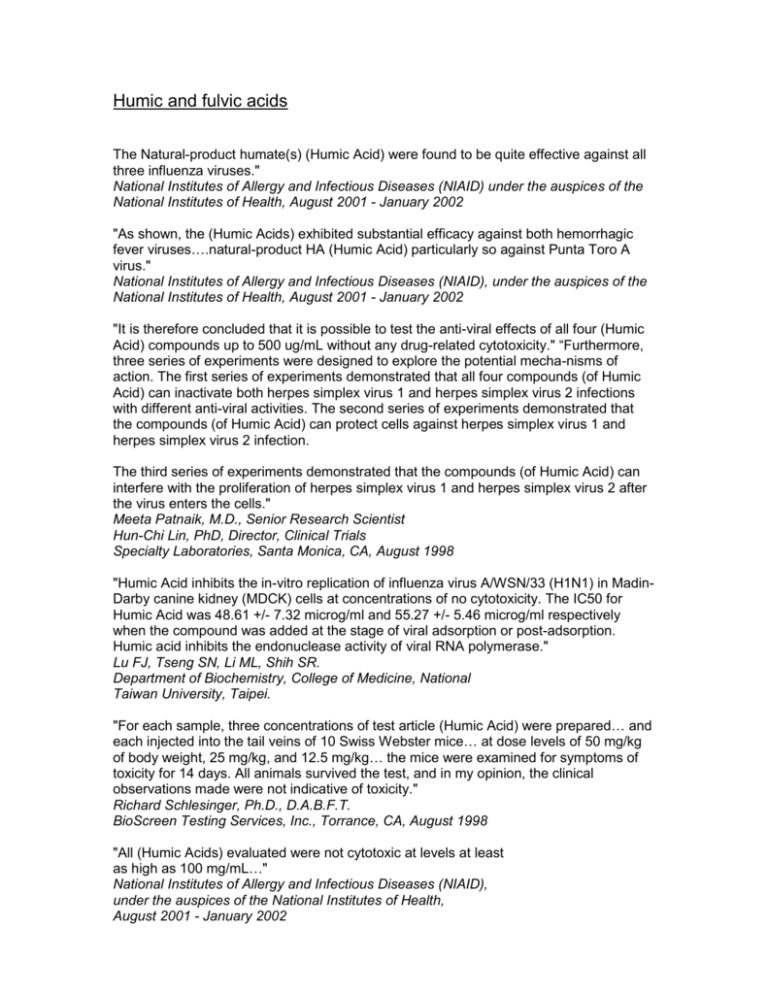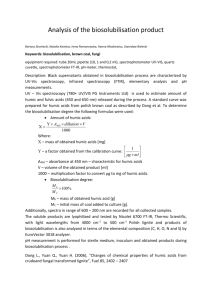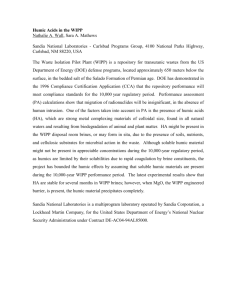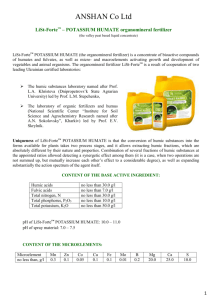More science on humic fulvic acids
advertisement

Humic and fulvic acids The Natural-product humate(s) (Humic Acid) were found to be quite effective against all three influenza viruses." National Institutes of Allergy and Infectious Diseases (NIAID) under the auspices of the National Institutes of Health, August 2001 - January 2002 "As shown, the (Humic Acids) exhibited substantial efficacy against both hemorrhagic fever viruses….natural-product HA (Humic Acid) particularly so against Punta Toro A virus." National Institutes of Allergy and Infectious Diseases (NIAID), under the auspices of the National Institutes of Health, August 2001 - January 2002 "It is therefore concluded that it is possible to test the anti-viral effects of all four (Humic Acid) compounds up to 500 ug/mL without any drug-related cytotoxicity." “Furthermore, three series of experiments were designed to explore the potential mecha-nisms of action. The first series of experiments demonstrated that all four compounds (of Humic Acid) can inactivate both herpes simplex virus 1 and herpes simplex virus 2 infections with different anti-viral activities. The second series of experiments demonstrated that the compounds (of Humic Acid) can protect cells against herpes simplex virus 1 and herpes simplex virus 2 infection. The third series of experiments demonstrated that the compounds (of Humic Acid) can interfere with the proliferation of herpes simplex virus 1 and herpes simplex virus 2 after the virus enters the cells." Meeta Patnaik, M.D., Senior Research Scientist Hun-Chi Lin, PhD, Director, Clinical Trials Specialty Laboratories, Santa Monica, CA, August 1998 "Humic Acid inhibits the in-vitro replication of influenza virus A/WSN/33 (H1N1) in MadinDarby canine kidney (MDCK) cells at concentrations of no cytotoxicity. The IC50 for Humic Acid was 48.61 +/- 7.32 microg/ml and 55.27 +/- 5.46 microg/ml respectively when the compound was added at the stage of viral adsorption or post-adsorption. Humic acid inhibits the endonuclease activity of viral RNA polymerase." Lu FJ, Tseng SN, Li ML, Shih SR. Department of Biochemistry, College of Medicine, National Taiwan University, Taipei. "For each sample, three concentrations of test article (Humic Acid) were prepared… and each injected into the tail veins of 10 Swiss Webster mice… at dose levels of 50 mg/kg of body weight, 25 mg/kg, and 12.5 mg/kg… the mice were examined for symptoms of toxicity for 14 days. All animals survived the test, and in my opinion, the clinical observations made were not indicative of toxicity." Richard Schlesinger, Ph.D., D.A.B.F.T. BioScreen Testing Services, Inc., Torrance, CA, August 1998 "All (Humic Acids) evaluated were not cytotoxic at levels at least as high as 100 mg/mL…" National Institutes of Allergy and Infectious Diseases (NIAID), under the auspices of the National Institutes of Health, August 2001 - January 2002 "…the ability to inhibit the replication of wild-type strains (of HIV-1) is an obvious (and, arguably, the most important) prerequisite in order that any HIV-1 drug be considered useful. The results obtained to date have shown that (natural) Humic Acid as well as synthetic humic acid(s) do, in fact, inhibit the replication of HIV-1 wild-type strains, in addition to assaulting in a unique way the intracellular replicative events of the virus." "It was found in this work that both synthetic as well as naturally-occurring humic substances extracted from soil are in fact capable of inhibiting HIV-1 replication." Research team at USC School of Medicine, January, 1998. "The Humates are potent inhibitors of acute HIV infection in antiviral evaluation models. The present studies point to an antiviral target occurring before proviral integration, possibly involving virus attachment and entry." "We were able to confirm antiviral activity for the humates and define their potential antiviral target to the pre-integration phase of HIV replication, providing preliminary data that a portion of the antiviral activity is due to inhibition of virus attachment." Jim A. Turpin Ph.D., Manager Retrovirus Research Laboratory Tracy Loftus, Supervisor Retrovirus Research Laboratory Southern Research Institute, September, 2000 "(Humic Acid) inhibited HIV-1 infection of MT-2 cells with an IC(50) of 12.5 microg/ml. Treatment of free and cell-attached HIV with (Humic Acid) irreversibly reduced infectivity, while the susceptibility of target cells to the virus was not impaired by treatment prior to infection. The infectivity of the HIV particles was inhibited by interference with CD4 binding and the V3 loop-mediated step of virus entry. No viral resistance to (Humic Acid) developed over a 12-week period in vitro. (Humic Acid) therefore holds promise for the treatment of HIV-infected patients." van Rensburg CE, Department of Pharmacology, University of Pretoria, Pretoria, South Africa; Dekker J, Enerkom (Pty) Ltd, Pretoria, South Africa; Weis R, Smith TL, Janse van Rensburg E, Schneider J. "Humic acids are natural constituents of soil and ground water and mainly consist of mixtures of polycyclic phenolic compounds. (Humic Acid) inhibited HIV-1 infection of MT2 cells with an IC50 of 50-300 ng/ml. Inhibition of HIV-induced syncytium formation was observed at 10-50 micrograms/ml. Treatment of free and cell-attached HIV with (Humic Acid) irreversibly reduced its infectivity. (Humic Acid) interfered with the CD4-induced proteolytic cleavage of the V3 loop of virion gp120SU. Furthermore, binding of V3 loopspecific antibodies was irreversibly inhibited, whereas binding of soluble CD4 to gp120SU on virus and infected cells was not affected. In conclusion, our data suggest, that the (Humic Acid) inhibits the infectivity of HIV particles by interference with a V3 loop-mediated step of virus entry." Schneider J, Weis R, Manner C, Kary B, Werner A, Seubert BJ, Riede UN. Abteilung Virologie, Institut fur Medizinische Mikrobiologie und Hygiene der Universitat, Freiburg, Germany. Other studies found that humic and fulvic acids: 1) increase the body’s intake of calcium and magnesium (alkalizing minerals) by 50%, sodium and potassium by 16%, and manganese, iron, and zinc by 80%, 2) help the liver metabolize the simple sugars leucine and uridine into adenosine triphosphate (ATP, the nucleotide commonly regarded in biochemistry as the “molecular currency” of intracellular energy transfer), and 3) combine with molecules that carry oxygen in your blood, which increases ATP and cellular energy. (Most diseases abhor oxygenated, aerobic environments.) There's also a story about a region in the Himalayas where, for thousands of years, it was commonly known that old monkeys didn't live at the tops of the mountains. Balding, gray ones were seen only at lower altitudes. The locals believed high-altitude monkeys died at a younger age because it's so hard to survive in rocky, barren landscapes where weather conditions are severe and food is scarce. But in the 1930s, a doctor kept track of the ages of the monkeys who lived at different altitudes, and he discovered something else. The ones up higher weren't dying at younger ages. They lived just as long as the ones below. But the monkeys at higher altitudes had a different diet. They were eating something that trickled out of the mountain bedrock. The doctor figured out what was happening. Moisture absorbed into bedrock froze in the winter. In the spring and summer, when the frozen moisture melted, it seeped through the pores and cracks of the rock, full of usable minerals from the earth. What the monkeys were eating was pure, pristine humate. Some References 1. Effects of humic acid on the viability and coagulant properties of human umbilical vein endothelial cells. Yang, H.L.; Chiu, H. C.; Lu, F. Am J. Hematol, 1996; Vol. 51, Issue 3, Pages 200-206. 2. Effect of humic acid on the availability of iodine in the food, investigated with the histometric assessment of the thyroid gland. Seffner, W. Conference Paper Mengen- und spurenelemente 15 Arbeltstagund, December 1995, Jena, Germany. Mengen Und Spurenelemente Pages 465472. 3. In-vivo and in-vitro mutagenicity studies on natural humic acid (HA). Bernacchi, F.; Ponzanelli, I.; Barale, R.; Bertelli, F. Conference Paper 37 Riunione scientifica , October 1991, Alghero, Italy. ATTI-Associazione Genetica Italiana, 1991, Vol. 37, Pages 49-50. Advanced Bioceuticals 9 4. The use of a processed humic acid product as a feed supplement in dairy production in the Netherlands. Thomassen, B. P. H.; Faust, R. H. Conference Paper IFOAM; IFOAM 2000, the world grows organic international scientific conference, August 2000, Basle. Page 339 5. Induction of oxidative stress by humic acid through increasing intracellular iron; a possible mechanism leading to atherothrombotic vascular disorder in blackfoot disease. Gau, R. J.; Yang, H. L.; Suen, J. L.; Lu, F. J. Biochem Biophys Res Commun, 2001; Vol 283; Issue 4; Pages 743749. 6. Humic acid induced growth retardation in a sertoli cell line, TM4. Chen, Y. J.; LinChao, S.; Huang, T. S.; Yan, M. L.; Lu, F. J. Life Sci, 2001; Vol. 69; Issue 11; Pages 1269-1284. 7. Effect of phenol ring polymers on the release of plasminogen activators. Klocking, H. P.; Klocking, R.; Helbig, B. Farmakol Toksikol, 1984; Vol. 47; Issue 1; Pages 93-95. 8. Effect of sodium humate on animals irradiated with lethal doses. Pukhova, G. G.; Druzhina, H. A.; Stepchenko, L. M.; Chebotarev, E. E. Radiobiologiia, 1987; Vol. 27; Issue 5; Pages 650-653. 9. Sodium humate in the treatment of osteoarthrosis patients. Iubitskaia, N. S.; Ivanov, E. M. Vopr Kurortol Fizioter Lech Fiz Kult, 1999; Issue 5; Pages 22-24. 10. Results of an oriented clinical trial of ammonium humate for the local treatment of herpesvirus hominis (HVH) infections. Schiller, F.; Klocking, R.; Wutzler, P.; Farber, I. Dermatoi Monatsschr, 1979; Vol. 165; Issue 7; Pages 505-509. 11. Comparison of the in vitro activities of ammonium humate and of enzymically oxidized chlorogenic and caffeic acids against type 1 and type 2 human herpes virus. Thiel, K. D.; Heibig, B.; Kloching, R.; Vutzier, P.; Sprossig, M.; Schweizer, H. Pharmazie, 1981; Vol. 36; Issue 1; Pages 50-53. 12. Humate induced activation of human granulocytes. Riede, U. N.; Zeck-Kapp, G.; Freudenberg, N.; Keller, H. U.; Seubert, B. Virchows Arch B Cell Pathol Incl Mol Pathol, 1991; Vol. 60; Issue 1; Pages 27-34. 13. The content of free amino acids in the tissues of broiler chicks administered sodium humate in the ration. Zhorina, L. V.; Stepchenko, L. M. Nauchnye Doki Vyss Shkoly Biol Nauki, 1991; Issue 10; Pages 147-150. 14. The effect of sodium humate on metabolism and resistance in highly productive poultry. Stepchenko, L. M.; Zhorina, L. V.; Kravtsova, L. V. Nauchnye Doki Vyss Shkoly Biol Mauki, 1991; Issue 10; Pages 90-95. 15. Experimental bases and prospects for the use of humic acid preparations from peat in medicine and agricultural production. Lotosh, T. D. nauchnye Doki Vyss Shkoly Biol Nauki, 1991; Issue 10; Pages 99-103. Advanced Bioceuticals 10 16. The effect of sodium humate on cadmium deposition in the organs of chickens. Herzig, I.; Hampi, J.; Docekalova, H.; Pisarikova, B.; Vicek, J. Vet Med, 1994; Vol. 39; Issue 4; Pages 175185. 17. Pharmacokinetics of sodium humate in chickens. Hampi, J.; Herzig, I.; Vicek, J. Vet Med, 1994; Vol 39; Issue 6; Pages 305-313. 18. Inhibition of HIV-1 in cell culture by synthetic humate analogues derived from hydroquinone; mechanism of inhibition. Schneider, J.; Weis, R.; Manner, C.; Kary, B,; Werner, A.; Seubert, B. J.; Reide, U. N. Virology, 1996; Vol. 218; Issue 2; Pages 389-395. 19. Caecal metaboliies and microbial populations in chickens consuming diets containing a mined humate compound. Shermer, C. L.; Maciorowski, K. G.; Bailey, C. A.; Byers, F. M.; Ricke, S. C. Journal of the science of food and agriculture, 1998; Vol. 77; Issue 4, Pages 479486. 20. Use of ristocetin cofactor activity in the management of von Willebrand disease. Ewenstein, B. M. Haemophilia, 2001; Vol 7; Suppl. 1; Pages 10-15. 21. In vitro studies of the antiviral activity of ammonium humate against herpes simplex virus type 1 and type 2. Thiel, K. D.; Klocking, R.; Schweizer, H.; Sprossig, M. Zentralbl Bakteriol, 1977; Vol. 239; Issue 3; Pages 304-321. 22. Laub developing humate with anti-HIV, HSV, HPV and other antiviral activity. Laub, R. Biotechnology Information Institute, February 2000. Antiviral Drug and Vaccine Development Information, Vol. 12, No. 2. ISBN 0897-9871. 23. H2S odor control system. Wagner Quarries Company. Press Release, October 2000, Sandusky, Ohio. www.wagnerquaries.com. 24. Effect of chemical treatments, ration composition and feeding strategies on gaseous emissions and odor potential of cattle feedyards. Parker, D.;Auvermann, B.; Greene, W. Prepublication Texas A&M Extension Service, December 2001. TAMU Ag Research and Extension Ctr. Amarillo, Tx. 25. Efficient waste and odor management for feedlots. Greene, L. W.; Cole, A.USDA/ARS. The Agriculture Program, Texas A&M University System, AGCOM 5-1-00. http://agprogram.tamu.edu; press release, May, 2000. 26. Field trials of dairy cattle. Mosley, R. Non-published research. Enviromate, Inc. August 1996. 27. Humate lab data. Bunch, G. Southwestern Laboratories, December 1981. Midland, Tx. File No. C-1950-X. Advanced Bioceuticals 11 28. Acute systemic toxicity studies of natural product and synthetic humates. Laub, R. Laub BioChem Corp, August 1998. www.laubbiochem.com. 29. The chemically induced inhibition of HSV infection. Laub, R. Laub BioChem Corp., August 1998. www.laubiochem.com. 30. The chemically induced inhibition of HIV-1 replication. Laub, R. Laub BioChem Corp., January 1995. www.laubiochem.com. 31. Process for preparing synthetic soil-extract materials and medicament based thereon. Laub, R. U. S. Patient No. 5,945,446, August 1999. 32. Studies on the antimicrobial effect of natural and synthetic humic acids. Ansorg R., et al., A rxeimittelforschung, 1978. Vol. 28, Issue 12, pages 2195-2198. 33. Investigations on the viricidal effects of humic acids in peat. Schultz, H. Tierarztl Vochenschr, July 1965, Vol. 72, Issue 13, pages 294-297. 34. Antiviral properties of humic acids. Klocking, R.; et al. Experientia, May 1972, Vol. 28, Issue 5, Pages 607-608. 35. The effects of phenolic polyments on retroviruses. Sydow, G.; et al. Pharmazie, December 1986. Vol. 41, Issue 12, Pages 865-868. 36. Therapeutic effect of E-5-2-bromovinyl 2-deoxyuridine, caffeic acid oxidation product, and trisodiumphosphonoformate on cutaneous herpes simplex virus type 1 infected guinea pigs. Helbig, B.; et al. Med Viral, 1987; Vol. 23; Issue 3; pages 303-309. 37. Interaction of humic acids and humic acid like polymers with herpes simplex virus type 1. Knocking, R. Humic Substances in the Aquatic and Terrestrial Environment, Berlin, 1991; pages 408-412. 38. Selective inhibitory activity of polyhydroxcarboxylates derived from phenolic compounds against human immunodeficiency virus replication. Schols, D.; et al. Acquir Immune Defic Syndr, 1991; Vol. 4; Issue 7, pages 677-685. 39. Hexaprenoid hydroquinones. Novel inhibitors of the reverse transcriptase of human iminunodeficiency virus type 1. Loya, S.; et al. Journal of Natural Products, December, 1993; Vol. 52, Issue 12; pages 2120-2125. 40. Effectiveness of phenol body polymers (Humic Acids) against influenza virus. Mentel, R., et al. Biochem Acta, 1983; Vol. 42;Issue 10; pages 1353-1356. 41. A randomized blind study on the efficacy of Tolpa Torf preparation in the treatment of recurring respiratory tract infections. Jankowski, A.; et al. Arch Immunol Ther Exp, 1993; Vol. 41. Issue 1; pages 95-97. Advanced Bioceuticals 12 42. Synthesis and characterization of humic acid like polymers. Hanainen, K. L.; et al. The Science of the Total Environment, 1987; Vol. 62; pages 201-210. 43. Comparison of the effect of natural and synthetic humates and EDTA on the growth of escherichia coli. Jakubiec, M.; et al. Arzneimittleforschung, 1978; Vol. 28; Issue 12; pages 2195-2198. 44. The use of the HET-CAM test for the determination of the irritating effect of humic acids. Wiegleb, K.; et al. Dtsch Tierarzl Wochenschr, October 1993; Vol. 100; Issue 10; pages 412416. 45. Effect of humates on microbial activity. Huck, T. A.; Porter, N.; Bushell, M. E. J. Gen. Microbiol., 1991; Vol. 137; Issue 10; pages 2321-2329. 46. Rich soils for cures. Achard, F. K. Creels Chem. Ann., 1986; Vol. 11; pages 391-403. 47. Humates and inflammation. Kuhnert, M.; et al. Arch. E-p. Veterinarmed., 1982; Vol. 36; pages 169-177. 48. Effects of Implanted bovine calcium hydroxyapatite with humate. Kreutz; Schlikekewey, W. Arch. Orthop. Trauma Surg., 1992, Vol. 111; Issue 5; pages 259-264. 49. Malinowska, M. H.; Pietraszek, D; Chabielska, E. Acta Pol. Pharm., 1993, Vol. 50; Issue 6; pages 507-511. 50. An examination of humate stimulated liver functions. Maslinski, C; Fogel, W. A.; Andrzejewski, W. Acta Pol. Pharm., 1993; Vol. 50; Issue 4-5; pages 413-416. 51. Visser, S. A. Sci. Total Environ.; 1987; Vol. 62; Issue 4; pages 347-354. 52. Brzozowski, T; Dembrinski, A.; Konturek, S. Acta Pol. Pharm., 1994; Vol. 51; Issue 1; pages 103-107. 53. Effects of bovipro on performance and serum metabolite concentrations of beef steers. Chirase, N. Amer. Soc. of Animal Sci. Proceedings; West Section No. 51, 2000.Z






